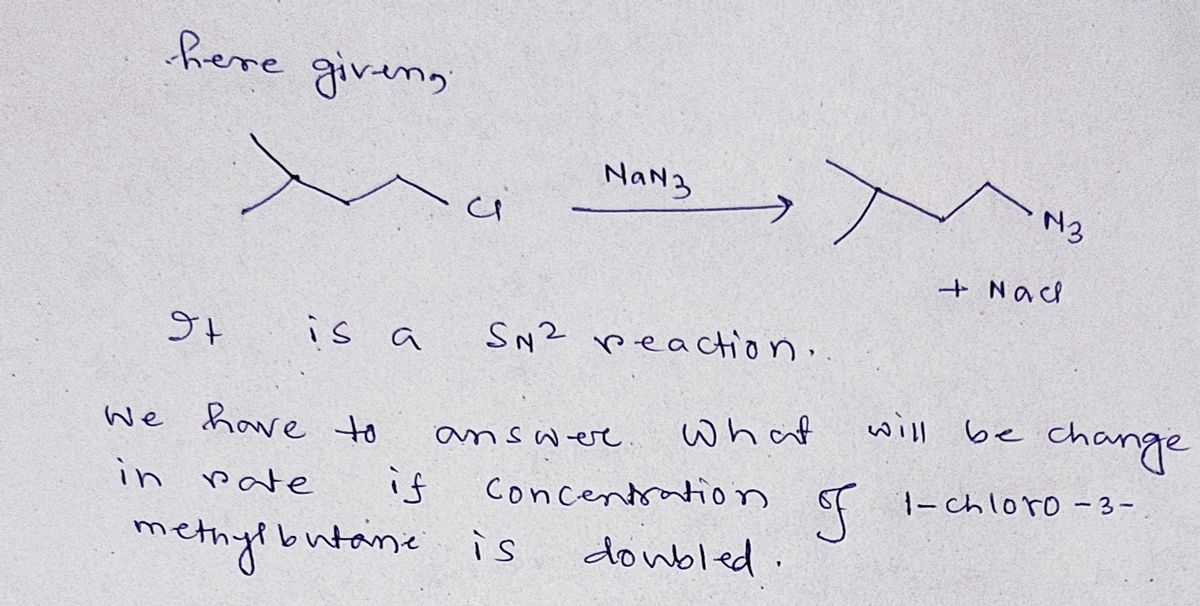Consider the following SN2 reaction, NaN3. a) It would double the rate d) No effect ملك Assuming no other changes, what is the effect on the rate, if the concentration of 1- chloro-3-methylbutane is doubled? Ob) It would increase four times Oc) It would reduce by half e) It would triple the rate N3 t + NaCl 7 III
Consider the following SN2 reaction, NaN3. a) It would double the rate d) No effect ملك Assuming no other changes, what is the effect on the rate, if the concentration of 1- chloro-3-methylbutane is doubled? Ob) It would increase four times Oc) It would reduce by half e) It would triple the rate N3 t + NaCl 7 III
Chemistry
10th Edition
ISBN:9781305957404
Author:Steven S. Zumdahl, Susan A. Zumdahl, Donald J. DeCoste
Publisher:Steven S. Zumdahl, Susan A. Zumdahl, Donald J. DeCoste
Chapter1: Chemical Foundations
Section: Chapter Questions
Problem 1RQ: Define and explain the differences between the following terms. a. law and theory b. theory and...
Related questions
Question
![**SN2 Reaction Rate Question for Educational Purposes**
Consider the following SN2 reaction:
**Chemical Equation:**
\[ \text{1-chloro-3-methylbutane} + \text{NaN}_3 \rightarrow \text{1-azido-3-methylbutane} + \text{NaCl} \]
**Question:**
Assuming no other changes, what is the effect on the rate if the concentration of 1-chloro-3-methylbutane is doubled?
**Options:**
a) It would double the rate
b) It would increase four times
c) It would reduce by half
d) No effect
e) It would triple the rate
**Explanation of SN2 Mechanism:**
The SN2 reaction is a type of nucleophilic substitution where the rate is dependent on the concentration of both the substrate (in this case, 1-chloro-3-methylbutane) and the nucleophile (sodium azide, NaN₃). This means that doubling the concentration of either reactant generally doubles the reaction rate, as each has a direct linear effect on the overall reaction rate. Thus, option (a) is correct: doubling the concentration of 1-chloro-3-methylbutane would double the rate of reaction.](/v2/_next/image?url=https%3A%2F%2Fcontent.bartleby.com%2Fqna-images%2Fquestion%2F434ecc5b-6045-4d47-9c46-b0141f1fac83%2F7e496906-0801-42dc-9269-8999c9584d30%2Fxihssei_processed.jpeg&w=3840&q=75)
Transcribed Image Text:**SN2 Reaction Rate Question for Educational Purposes**
Consider the following SN2 reaction:
**Chemical Equation:**
\[ \text{1-chloro-3-methylbutane} + \text{NaN}_3 \rightarrow \text{1-azido-3-methylbutane} + \text{NaCl} \]
**Question:**
Assuming no other changes, what is the effect on the rate if the concentration of 1-chloro-3-methylbutane is doubled?
**Options:**
a) It would double the rate
b) It would increase four times
c) It would reduce by half
d) No effect
e) It would triple the rate
**Explanation of SN2 Mechanism:**
The SN2 reaction is a type of nucleophilic substitution where the rate is dependent on the concentration of both the substrate (in this case, 1-chloro-3-methylbutane) and the nucleophile (sodium azide, NaN₃). This means that doubling the concentration of either reactant generally doubles the reaction rate, as each has a direct linear effect on the overall reaction rate. Thus, option (a) is correct: doubling the concentration of 1-chloro-3-methylbutane would double the rate of reaction.
Expert Solution
Step 1

Trending now
This is a popular solution!
Step by step
Solved in 2 steps with 2 images

Knowledge Booster
Learn more about
Need a deep-dive on the concept behind this application? Look no further. Learn more about this topic, chemistry and related others by exploring similar questions and additional content below.Recommended textbooks for you

Chemistry
Chemistry
ISBN:
9781305957404
Author:
Steven S. Zumdahl, Susan A. Zumdahl, Donald J. DeCoste
Publisher:
Cengage Learning

Chemistry
Chemistry
ISBN:
9781259911156
Author:
Raymond Chang Dr., Jason Overby Professor
Publisher:
McGraw-Hill Education

Principles of Instrumental Analysis
Chemistry
ISBN:
9781305577213
Author:
Douglas A. Skoog, F. James Holler, Stanley R. Crouch
Publisher:
Cengage Learning

Chemistry
Chemistry
ISBN:
9781305957404
Author:
Steven S. Zumdahl, Susan A. Zumdahl, Donald J. DeCoste
Publisher:
Cengage Learning

Chemistry
Chemistry
ISBN:
9781259911156
Author:
Raymond Chang Dr., Jason Overby Professor
Publisher:
McGraw-Hill Education

Principles of Instrumental Analysis
Chemistry
ISBN:
9781305577213
Author:
Douglas A. Skoog, F. James Holler, Stanley R. Crouch
Publisher:
Cengage Learning

Organic Chemistry
Chemistry
ISBN:
9780078021558
Author:
Janice Gorzynski Smith Dr.
Publisher:
McGraw-Hill Education

Chemistry: Principles and Reactions
Chemistry
ISBN:
9781305079373
Author:
William L. Masterton, Cecile N. Hurley
Publisher:
Cengage Learning

Elementary Principles of Chemical Processes, Bind…
Chemistry
ISBN:
9781118431221
Author:
Richard M. Felder, Ronald W. Rousseau, Lisa G. Bullard
Publisher:
WILEY